DAYTONA: Is It Too HOT To HANDEL?
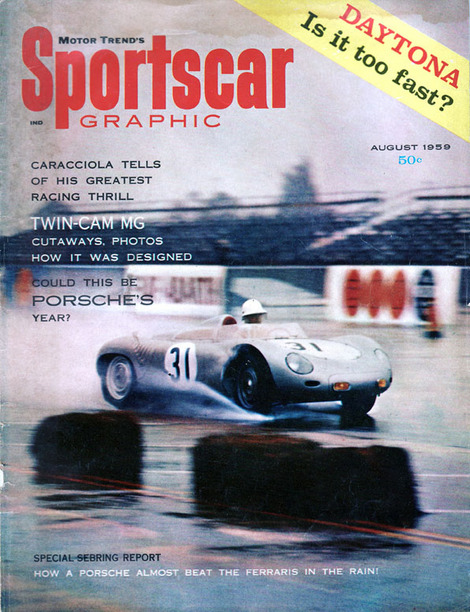
Daytona International Speedway is a superspeedway in Daytona Beach, Florida. It is a 2.5 miles (4.0 km) tri-oval race track facility with a seating capacity of 168,000 spectators. It hosts races of motor vehicles of various kinds, including go-karts, motorcycles (on and off road), sports cars, modified pickup trucks, and stock cars. Since 1959, it has been the home to the most important race in the NASCARSprint Cup Series, the Daytona 500. The facility also includes a 3.56 miles (5.73 km) road course and a 180-acre (73 ha) infield, including the 29-acre (12 ha) Lake Lloyd, which has hosted powerboat racing. The facility is also used for an annual spring car show and swap meet, and a Thanksgiving street rod meet, some of the largest of their kind, and various 5,000 metres (3.1 mi) races around the track, as there have been three different layouts.
Daytona: Is It Too HOT To HANDEL?
The newest and finest racing facility in the world poses unforeseen race car control and handling problems.
by Wayne Thoms photos by Bob D'Olivo and Taylor Warren
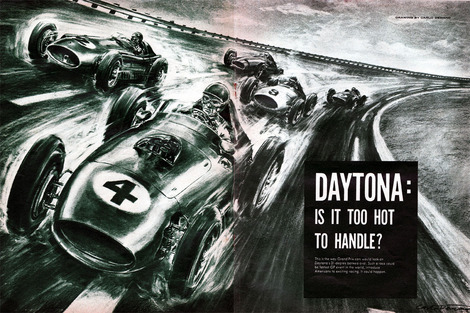 This is the way Grand Prix cars would look on Daytona's 31-degree banked oval. Such a race could be fastest GP event in the world, introduce Americans to exciting racing. It could happen. Drawing by Carlo Demand.
This is the way Grand Prix cars would look on Daytona's 31-degree banked oval. Such a race could be fastest GP event in the world, introduce Americans to exciting racing. It could happen. Drawing by Carlo Demand.
Carved from swampy Florida jungle in a year of feverish construction, the Daytona Beach International Speedway has proven too be everything its builders hoped, plus a few things they weren't anticipating. As the first new 2.5-mile track in America in 50 years, it has captured the imagination of sports fans everywhere. And when the $3 million racing plant opened in February of this year, world records were immediately set virtually every type of racing car which stormed around the asphalt banks.
Daytona puts into operation a concept which is somewhat unusual in racing - spectator convenience. It is actually possible to see the entire oval and infield road course from any seat in the stands and from the infield standing area. The course is loaded with facilities, including a lake for fishing and boat racing, a small well-equipped hospital, a 50-foot high telesign which flashes messages of spectator interest within seconds, first aid stations, a cafeteria for the pit area, covered garages, auto tunnels for infield entrance and exit during a race and others which add to spectator pleasure.
Motivating force behind the speedway is 49-year-old Bill France, also president and founder of NASCAR (National Association for Stock Car Auto Racing). France parlayed a long-time interest in auto racing into personal participation, eventually (1938) taking over the promotion of racing events on Daytona's famed beach course. But a few years ago he realized that development of the beach areas would eventually eliminate racing over the old beach-road course. So came into being his dream - to build the world's finest super-speedway in Daytona Beach.
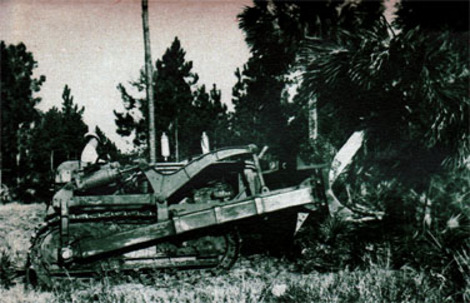 Start of Daytona Speedway construction saw bulldozers hacking out 350 acres of Florida swampland before actual building could get underway. Because land is at sea level, special techniques were required for digging.
Start of Daytona Speedway construction saw bulldozers hacking out 350 acres of Florida swampland before actual building could get underway. Because land is at sea level, special techniques were required for digging.
 Heavy equipment used to spread limerock on banked turns had to be anchored by cable from second tractor on perimeter road to prevent slipping on the 31-degree bank. Hardened limerock 8 inches thick is solid base.
Heavy equipment used to spread limerock on banked turns had to be anchored by cable from second tractor on perimeter road to prevent slipping on the 31-degree bank. Hardened limerock 8 inches thick is solid base.
After the usual problems, setbacks and disappointments which attend any enterprise of this magnitude, France built his dream track. And if the opinions of impartial racing experts from all parts of the world are meaningful, then he has succeeded in putting up the finest in the world.
As for the technical details of the track, they are impressive. From the 448-acre tract of land more than 928,000 cubic yards of dirt, mud, shellrock were removed in building the track. Most of this material was pulled from the infield area which is now 3000-foot long Lake Lloyd, to form the foundation for the track portion. East and west banks are elevated 24 feet above the level of the rest of the course, forming 31-degree flat banking. The south straightaway is 400 feet long but on the north side, where the grandstands are located, the straight is broken into two 1320-foot sections which join at a slight apex which has it own 18-degree bank. Because the course is virtually at sea level, a major problem was the shoring and pumping required to keep excavations dry during construction.
Some 22,000 tons of limerock were hauled from nearby Ocala, Fla. Chief advantage of limerock is that after it was spread over the track base in an eight-to-ten-inch layer and throughly wet down, it hardened into a concrete-like base over which asphalt was laid.
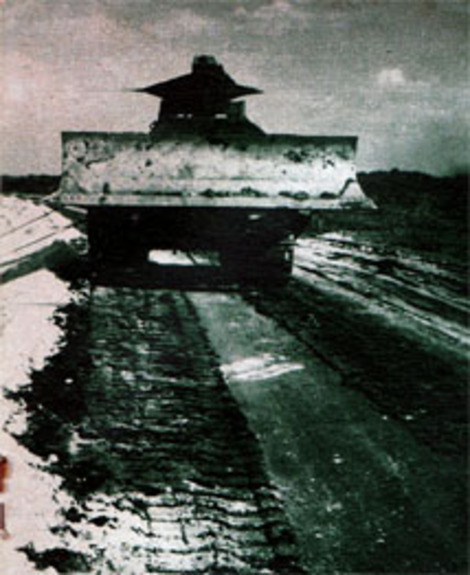 Heavy equipment packing limerock.
Heavy equipment packing limerock.
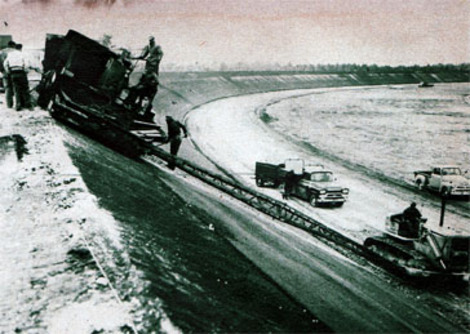 Asphalting the steep turns require special paving equipment and sure-footed workmen. Turns are 1000-foot radius, 67 feet wide, can be driven at 160 mph. Straightaway speeds with Indy cars exceed 190.
Asphalting the steep turns require special paving equipment and sure-footed workmen. Turns are 1000-foot radius, 67 feet wide, can be driven at 160 mph. Straightaway speeds with Indy cars exceed 190.
Safety has not been overlooked. In front of the five grandstands is a 3000-foot-long, 3.5-foot-high concrete wall, topped with a 10-foot safety fence on steel posts elevated toward the track. Chain link fences around the infield keep spectators an ample distance from the track, yet allow adequate vision. Around the course is one of the heaviest guard rails in racing, constructed from 10-gauge steel, 12 inches wide, supported by seven-foot posts at six-foot intervals. Set at right angles to the top of the high banking, it appears unlikely that a car could go over. If this should happen, there is a protective 20-foot-wide perimeter road completely around the course. Dust, that old enemy of race spectators, is no problem at Daytona. Nearly 200 acres, including the infield, have been planted with 15 tons of grass seed.
Parking facilities, both inside and outside the track, will accommodate nearly 35,000 cars; grandstand seating in the five stands named for racing greats - Barney Oldfield, Ralph DePalma, Sir Malcolm Campbell, Sir Henry Segrave, and Ray Keech - will take care of about 15,000 persons. There is infield space for what amounts to nearly an unlimited number of persons who prefer to be mobile.
About the track itself? Physically, it is 55 feet wide along the straights and 67 feet wide on the 1000-foot-radius turns. Since the tragic deaths of Marshall Teague and George Amick within a few weeks of the tracks opening, critics have charged that the course is unsafe; that it's just too fast. Unsafe? Not to hear the drivers tell it. The basic problem is there is no room for error at the speeds attainted by Indianapolis cars. In order to average 170 mph (Amick set a one-lap American course record of 176.887 just before his death) a car must hit 190 or better on the straight, braking to about 160 for the turn. At speeds aerodynamics of car design become extremely important. Mechanically, the cars will take it but nobody really knows what slipstream forces are acting upon them. Wind tunnel tests have been suggested.
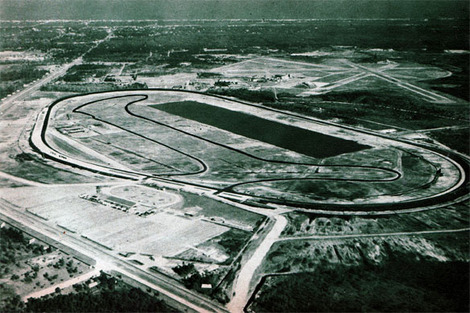 Aerial view of Daytona Speedway outlines 2.5 - mile tri-oval plus connecting 2.1-mile infield road course. Also on infiekd is 3000-foot lake for boat racing and fishing. At top is city of Daytona and ocean.
Aerial view of Daytona Speedway outlines 2.5 - mile tri-oval plus connecting 2.1-mile infield road course. Also on infiekd is 3000-foot lake for boat racing and fishing. At top is city of Daytona and ocean.
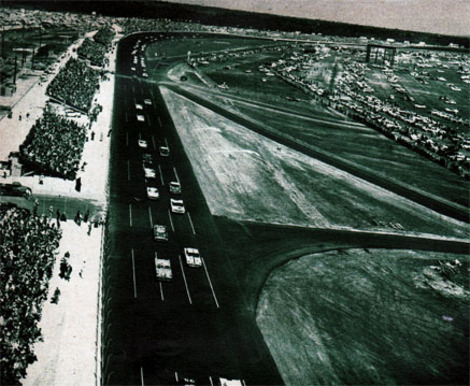 This was scene at start of NASCAR 500-mile Sweepstakes, inaugural race at Daytona. View looks east to apex of 18-degree bank in front of the stands; start of high bank is visible extreme upper right. Hairpin turn in foreground is connecting link for the road course which is run in opposite direction from the stock cars. Tower-looking structure at upper right is 50-foot-high telesign for spectators.
This was scene at start of NASCAR 500-mile Sweepstakes, inaugural race at Daytona. View looks east to apex of 18-degree bank in front of the stands; start of high bank is visible extreme upper right. Hairpin turn in foreground is connecting link for the road course which is run in opposite direction from the stock cars. Tower-looking structure at upper right is 50-foot-high telesign for spectators.
To add to the drivers' troubles are almost daily crosswinds which can reach gusts of 20 mph. Watch the drivers steering out of a turn - fighting is more appropriate - and you'll understand.
Shortly after Amick's death, United States Auto Club racing director Henry Banks announced that USAC speedway cars would no longer be allowed to run at Daytona, at least until they had an opportunity to investigate the problem throughly. Banks said that he felt that the course was basically well designed, just too advanced for current high-speed equipment.
The racing of stock cars is another story. Drivers are protected with a tubular cage many times stronger than the roll bar carried on an Indy car. The stockers have made some wild spins and flips at high speeds without fatal consequences. A stock car will rarely exceed 155 mph on the straight.
 Insert: Jim Rathmann holds a position in the second of the four available grooves as he fights a vicious crosswind at 160 mph on the east bank. Speedway cars in practice laps for March race where they averaged over 170 mph in worlds fastest race.
Insert: Jim Rathmann holds a position in the second of the four available grooves as he fights a vicious crosswind at 160 mph on the east bank. Speedway cars in practice laps for March race where they averaged over 170 mph in worlds fastest race.
 Loyal Katskee in Ferrari chases Fred Windridge in Lister around west bank during first sportscar race on course. Katskee finished 4th.
Loyal Katskee in Ferrari chases Fred Windridge in Lister around west bank during first sportscar race on course. Katskee finished 4th.
There is talk of staging an honest Grand Prix race with European teams on combined oval and infield road course which totals 4.5 miles. It was just such a recent conversation between Bill France and a pair of Britons influential in racing which inspired our opening drawing. The mere thought of a full complement of GP cars coming full-bore through the banks three and four abreast - perfectly possible - should be enough to make racing enthusiasts from all over the country flock to Daytona. And why shouldn't GP cars race there? The cars are tentatively scheduled for Sebring this December and Sebring is only 165 miles from Daytona. If it happened, we wouldn't miss it.
After a few laps at speed well below racing levels, yet fast enough to get the feel of the course, we can truthfully say that we were overwhelmed. It's amazingly smooth - only a few bumps in the turns. It takes at least 80 mph to stay on the high bank; at speeds below that a car will simply slide down, generally tail first. In the banked turns at 100 mph we found ourselves looking down and out, attempting to see around the radius which seems to hem the driver in. Even at these speeds in a station wagon (with extra air in the tires) we found it quite comfortable and natural to carry on a conversation with three passengers. At the century mark there is only the slightest feeling of "G" force; at 150 mph it becomes about 1.5 G's - not excessive but drivers claim it is fatiguing over a lengthy race.
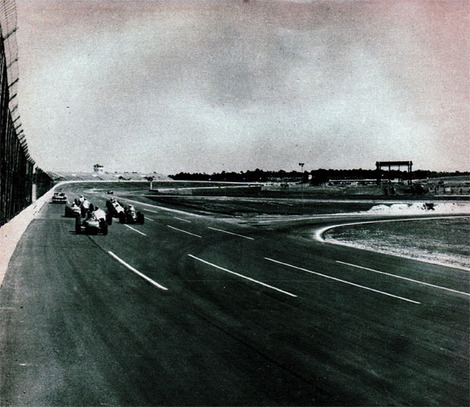 Indy cars in practice sessions turned world record speeds. Cars have been banned at course following two deaths.
Indy cars in practice sessions turned world record speeds. Cars have been banned at course following two deaths.
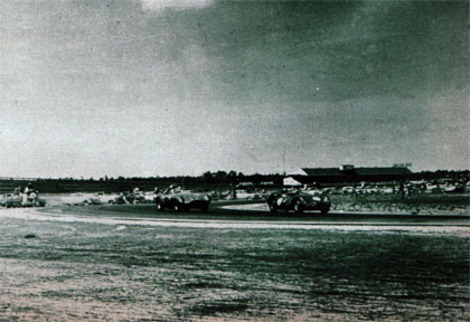 Loyal Katskee's Ferrari moves out to pass A.J. Foyt's Lister on road section. Katskee drove 500-miles without relief.
Loyal Katskee's Ferrari moves out to pass A.J. Foyt's Lister on road section. Katskee drove 500-miles without relief.
Daytona is a great course, a tremendous contribution to racing which may not be appreciated fully for several more years. Very prophetic statement.
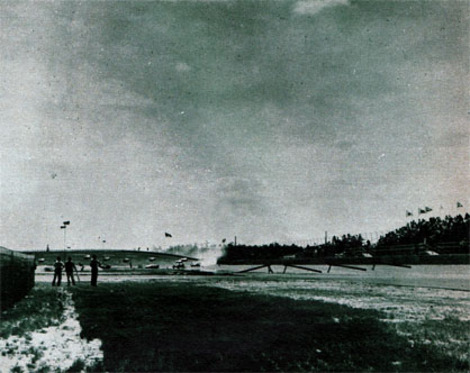 Sportscars loop sharply from high bank to infield. Course was temporarily shortened to 3.8 miles for first event.
Sportscars loop sharply from high bank to infield. Course was temporarily shortened to 3.8 miles for first event.
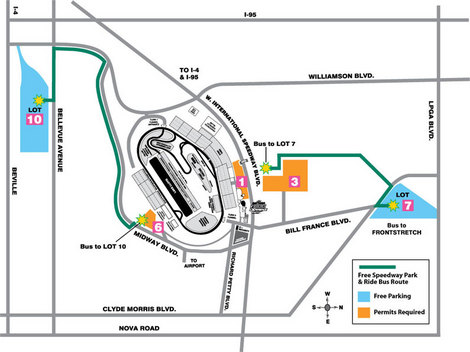 current map of the area.
current map of the area.
 current map of the track.
current map of the track.
Daytona tribute.
A few shots from last years race.
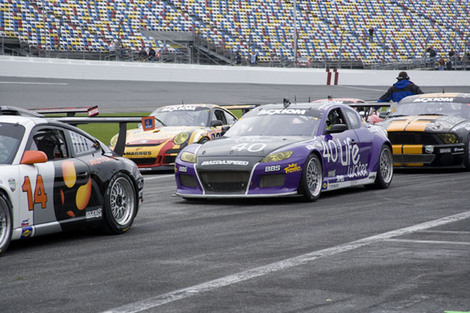
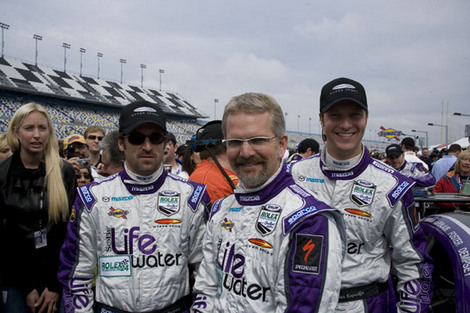
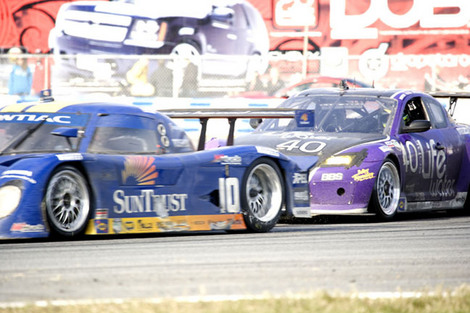
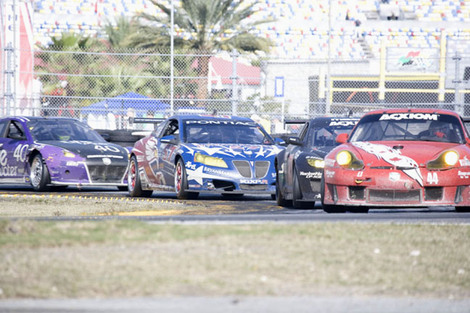
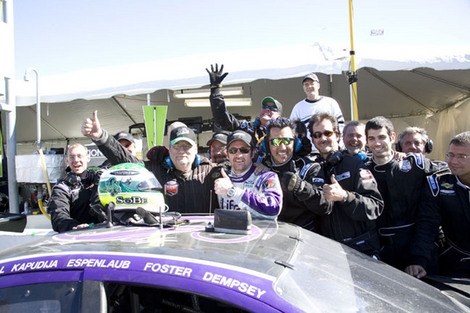
Some more historical information and a look at the 24 hours of Daytona:
Course history
NASCAR was founded by William France Sr. and a small group of fellow race promoters at Daytona Beach, Florida in 1947. The original premiere event in the series was held at the Daytona Beach Road Course. France began planning a new track for the premiere event in his fledgling series in 1953. On August 16, 1954 he signed a contract with city officials to create this new track that would become famous as the Daytona International Speedway. Ground was broken on November 25th, 1957. The soil underneath the banked corners was dug from the infield of the track, and the large hole in the infield filled with water from the low water table and is now known as Lake Lloyd. The speedway opened on February 22, 1959 to a crowd of 41,000 people.
The track was almost not complete for that first race date, however. In 1958, needing more money to meet his goal, France traveled to Atlanta to meet with the Coca-Cola company to hopefully get funding to complete construction. Coca-Cola officials told him he would never finish it on time and refused to fund it. France then went to the Pepsi-Cola company, then headquartered in North Carolina, and they cut him a check on the spot. Because of this Pepsi, and not Coca-Cola, would come to be sold at all NASCAR Tracks that the France family owned, until 2008, when Pepsico changed its focus to mainly sponsorship of Hendrick Motorsports. Coca-Cola has sided with most independent tracks, and rival Speedway Motorsports most notably, but there is an ISC transition with Coca-Cola that started with the 2008 Daytona 500 and continues with most ISC tracks, as Coca-Cola and NASCAR signed an official product deal starting in 1998, and was renewed until 2017. The new ten-year deal that started in 2008 will also phase in Coca-Cola pouring rights to most ISC tracks.
The Daytona 500, the most important race for NASCAR's premier series, is held annually at Daytona International Speedway. It is a 200-lap, 500 mile (805 km) stock car race. The list of Daytona 500 winners dates back to the inaugural race in 1959, and includes Richard Petty, A.J. Foyt, Mario Andretti, and Dale Earnhardt. NASCAR, the premier stock car organization in the United States, holds some of its most important races on this track. These include competitions in its Craftsman Truck Series (where pickup trucks are raced), Nationwide Series (the stock car junior league), and Sprint Cup Series. The 24 Hours of Daytona is also held at Daytona.
The racing season begins at Daytona starting with the testing sessions. The year's racing begins with Speedweeks, starting with the 24 Hours of Daytona race in the Grand American Sports Car series. Then the racing begins for theSprint Cup Series with the Budweiser Shootout and the Gatorade Duel. TheARCA RE/MAX Series Daytona ARCA 200 is held the same day as the Budweiser Shootout, a few hours prior to the Shootout. The Craftsman Truck Series begins with the Chevy Silverado 250. The Nationwide Series begins with the Camping World 300 and then it is back to the Sprint Cup in "The Great American Race", the Daytona 500. The Sprint Cup Series also features theCoke Zero 400 in July at Daytona. Lights were installed in 1998 so that the Pepsi 400 could be held at night.Musco Lighting was responsible for this event; and was officially known as "The World's Largest Single Lighted Outdoor Sports Facility"[1]before being surpassed by Losail International Circuit. However, the race was delayed until October that year due to thick smoke from wildfires that summer. The Pepsi 400 has been held under lights ever since. In 2005, the infield road course was reconfigured for motorcycles. Due to fears of tire wear on the banked oval sections, oval turns 1 and 2 were bypassed. [2]
The course is also used for Indy Racing League testing. It is one of the two tracks on the Sprint Cup Series circuit that uses restrictor plates to slow the cars down due to the high speeds, the other being Talladega Superspeedway. However, there are some differences in the racing at the two tracks, as Daytona is narrower and more handling-oriented than Talladega, which allows the huge packs to break up somewhat on long runs, which makes "the Big One" that plate tracks are famous for less frequent and usually on a start or restart, as opposed to Talladega, where such huge wrecks occurs in almost every race in almost any situation. Over the years, the track asphalt has worn. During Sprint Cup testing in January 2008, drivers complained about the grip of the track and the cracks and bumps on the surface. It also contains an attraction called the Daytona 500 Experience. The winning car from the Daytona 500 is placed inside the attraction building each year.
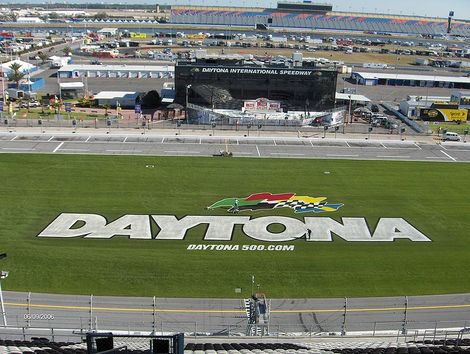
The Rolex 24 at Daytona (frequently referred to by its historical title, the 24 Hours of Daytona) is a 24-hour sports car endurance race held annually at Daytona International Speedway in Daytona Beach, Florida. It is held on a 3.56-mile (5.73 km) combined road course, utilizing portions of the NASCAR tri-oval and an infield road course. Since its inception, it has been held the last weekend of January or first weekend of February, part of Speedweeks, and it is the first major automobile race of the year in the United States. The race has had several names over the years. Since 1991, the Rolex Watch Co. is the title sponsor of the race under a naming rights arrangement, replacing Sunbank(now SunTrust) which in turn replaced Pepsi in 1984. Winning drivers of all classes receive a steel Rolex Cosmograph watch.
Beginnings
In 1962, a few years after the track was built, a 3-hour sports car race was introduced, the Daytona Continental, which counted towards the World Sportscar Championship. The first Continental was won by Dan Gurney, driving a 2.7L Coventry Climax powered Lotus 19, dubbed the Monte Carlo after Stirling Moss bringing Lotus their first Formula One win at Monaco in 1960 despite being a factory driver for Porsche at that time. Many Porsche 718s were driven by privateers, but these 1600 cc cars were considered rather underpowered for a relatively short and fast race despite having won the twisty Targa Florio and the tough 12 Hours of Sebring.
In 1964, the event was expanded to 2000 km (1220 miles), doubling the classic 1000 km distance of races at Nürburgring, Spa andMonza. The distance amounted to roughly the half of the distance the 24 Hours of Le Mans winners covered at the time and was similar in length to the Sebring 12 hour race, which was also held in Florida a few weeks later in the year. Starting in 1966, the Daytona race was extended to the same 24 hour length as Le Mans. [edit]24-hour history
As in the Spa 24 Hours (introduced in 1924) and the 24 Hours Nürburgring (1970), the purpose of the event is to determine which team of drivers can take their sports car the farthest in a fixed time period, rather than the shortest time over a fixed distance as in most conventional auto races. Unlike the Le Mans event, the Daytona race is conducted entirely over a closed course within the speedway arena without the use of any public streets. Most parts of the steep banking are included, interrupted with a chicane on the back straight and a sweeping, fast infield section which includes two hairpins. As unlike Le Mans, the race is held in wintertime, when nights are at their longest. There are lights installed around the circuit for night racing, although the infield section is still not as well-lit as the main oval. However, the stadium lights are turned on only to a level of 20%, similar to the stadium lighting setup at Le Mans, with brighter lights around the pit straight, and decent lighting similar to street lights around the circuit.
A car must cross the finish line after 24 hours to be classified, which leads to dramatic scenes where damaged cars wait in the pits or on the edge of the track close to the finish line for hours, then restart their engines and crawl across the finish line one last time in order to finish after the 24 hours and be listed with a finishing distance, rather than dismissed with DNF (Did Not Finish). This was the case in the initial 1962 Daytona Continental (then 3 hours), in which Dan Gurney's Lotus had established a lengthy lead when the engine failed with just minutes remaining. Gurney stopped the car at the top of the banking, just short of the finish line. When the three hours had elapsed, Gurney simply cranked the steering wheel to the left (toward the bottom of the banking) and let gravity pull the car across the line, to not only salvage a finishing position, but actually win the race. This led to the international rule requiring a car to cross the line under its own power in order to be classified. Ironically, Gurney himself fell afoul of the new rule at the Sebring 12 Hours in 1966, when the engine in his race-leading Ford GT failed with two minutes remaining. Gurney, in his frustration, attempted to push his car across the line, leading to his disqualification.
After having lost in 1966 both at Daytona and at Le Mans to the Fords, the Ferrari P series prototypes staged a triumphant 1-2-3 side-by-side parade finish at the banked finish line in 1967. To celebrate the victory over the rival at his home race, Ferrari named its V12-powered road car Ferrari Daytona after the race. Porsche repeated this show in their 1-2-3 win in the 1968 24 Hours. After the car of Gerhard Mitter had a big crash caused by tyre failure in the banking, his teammate Rolf Stommelen supported the car of Vic Elford/Jochen Neerpasch. When the car of the longtime leaders Jo Siffert/Hans Herrmann dropped to second due to a technical problem, these two also joined the new leaders while continuing with their car. So Porsche managed to put 5 of 8 drivers on the center of the podium, plus Jo Schlesser/Joe Buzzetta finishing in 3rd place, with only Mitter being left out. In 1972, due to the energy crisis, the race was shortened to 6 hours, while for 1974 the race was cancelled altogether. In 1982, following near-continuous inclusion on the World Sportscar Championship, the race was finally dropped as the series attempted to cut costs by both keeping teams in Europe and running shorter races. The race continued on as part of the IMSA GT series.
The regular teams were expanded to 3 drivers in the 1970s. Nowadays, often four or five drivers compete, with occasional "taxi" rides for less lucky team mates adding to the total. The winning entry in 1997 featured as many as seven drivers taking a turn in the cockpit. [edit]Grand American & Daytona Prototypes
After ownership problems with IMSA in the 1990s, the Daytona event aligned with the Grand-Am series, a competitor of the American Le Mans Series, which, as its name implies, uses the same regulations as the Le Mans Series and the 24 Hours of Le Mans, though Le Mans 24H itself is not on the ALMS calendar. The Grand Am series, though, is instead closely linked to NASCAR and its focus is on controlled costs and close competition. In order to make sports car racing less expensive than elsewhere, new rules were introduced in 2002. The dedicated Daytona Prototypes use less expensive materials and technologies and the car's simple aerodynamics reduce the development and testing costs.
Specialist chassis makers like Riley, Doran, Fabcar and Crawford provide the DP cars for the teams and the engines are branded under the names of major car companies like Pontiac, Lexus and Porsche. Unlike elsewhere, the vehicles are designated Engine-Chassis at Daytona (e.g. "Lexus-Riley"), as the chassis makers are rather unknown and do not sell road cars, similar to many specialised race car manufacturers. Changes are being made for 2007, however, with new rules encouraging chassis makers and automobile manufacturers to manufacture special chassis for one type of car only, thus enabling manufacturers to label the cars as prototype versions of their roadgoing brethren. Daytona GTs
The Gran Turismo class cars at Daytona are closer to the road versions, similar to the GT3 class elsewhere. For example, the more standard Cup version of the Porsche 996 is used, instead of the usual RS/RSR racing versions. Recent Daytona entries also includeBMW M3s, Corvettes, Mazda RX-8s and Pontiac GTO.Rs. In an effort for teams to save money, GT rules have now changed to permit spaceframe cars clad in lookalike body panels to compete in GT (the new Mazda for example, and the forthcoming Infiniti G35). These rules are somewhat similar to the old GTO specification, but with rather more restrictions. The intent of spaceframe-clad cars is to allow teams to save money -- especially after crashes, where teams can rebuild the cars for the next race at a much lower cost, or even redevelop cars, instead of having to write off an entire car after a crash or at the end of a year.
A couple of track views from DBIS website.
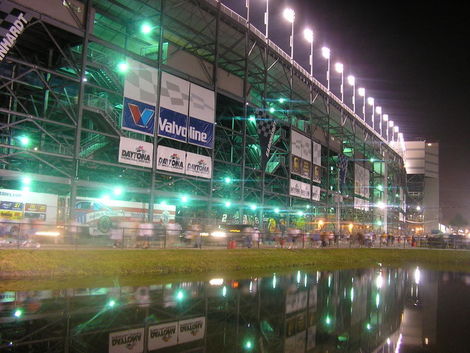
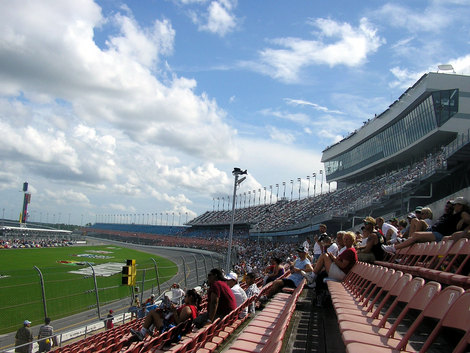
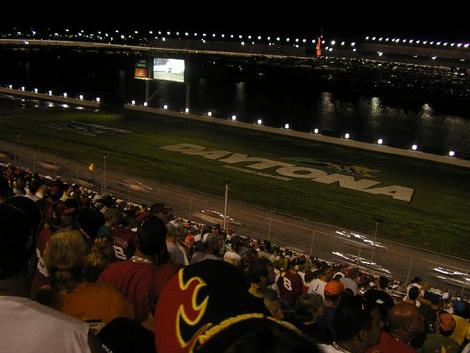
Posted 01/16/09 @ 09:08 PM | Tags: Daytona International Speedway, Daytona Beach, 24 hrs of Daytona, Hypersport Racing, Patrick Dempsey race car driver, Dempsey Racing, Daytona Prototypes, Sports Car Graphic August 1959, Rolex 24 at Daytona, Bill France, NASCAR, Formula One, Barney Oldfield, Ralph DePalma, Sir Malcolm Campbell, Sir Henry Segrave, Ray Keech, Marshall Teague, George Amick, Romeo Kapudija, Sports Car Graphic magazine